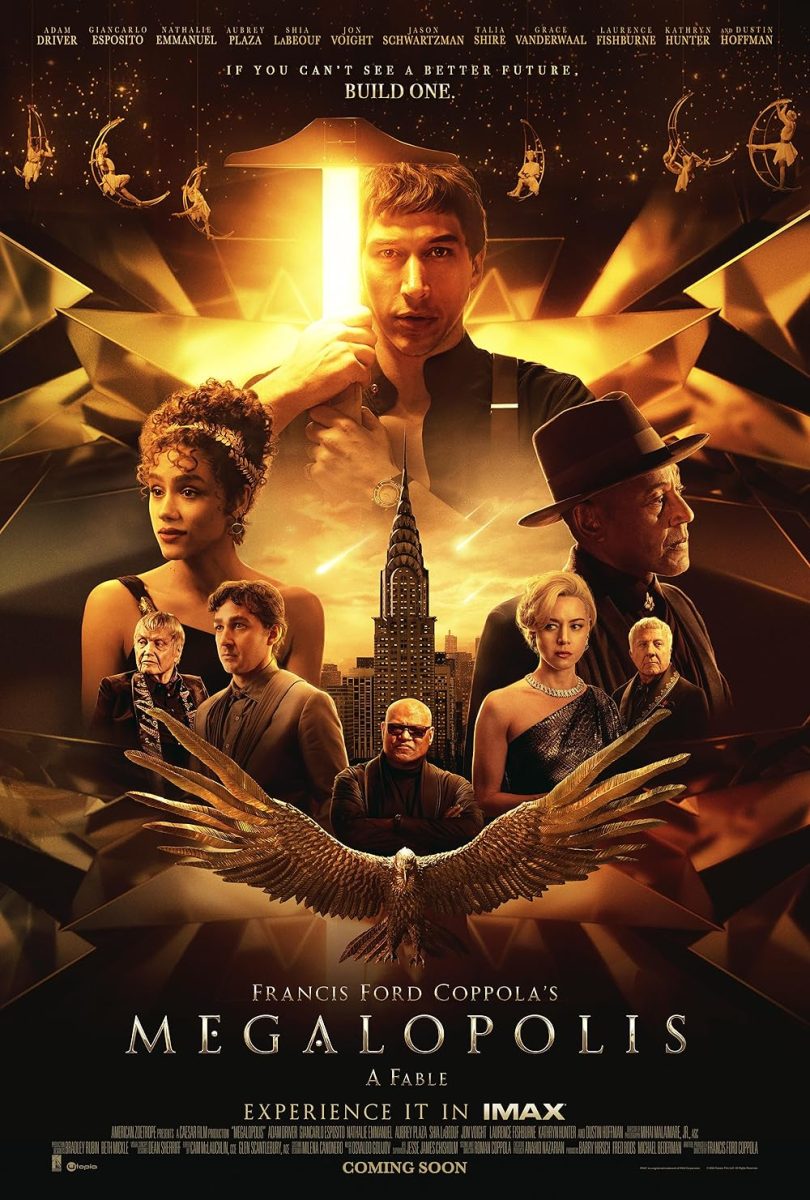“Megalopolis” is the latest dramatic “fable” from director, writer and producer Franics Ford Coppola. Renowned for iconic films such as “Apocalypse Now” (1979) and The Godfather series, Coppola returns with a fresh story that merges classic and contemporary styles.
Coppola retells the story of the fall of Rome in a new way. It is set in modern-day America in New Rome, an alternative version of New York where the values of ancient Rome have persisted throughout the centuries. Cesar Catilina (Adam Driver), is a visionary architect who seeks to rebuild the city with a newly discovered compound called Megalon, which follows him to stop time. Cesar fights to achieve his utopian visions against the wishes of the conservative Mayor Cicero (Giancarlo Esposito) and his jealous cousin Clodio (Shia LaBeouf), who quickly rises to power.
After nearly 30 years of on-and-off production, “Megalopolis” was finally released. However, the result is a rambling, underdeveloped story, salvaged by an interesting concept and great performances from well-known actors, some who haven’t been in the spotlight for a while.
The film’s setting and world building in “Megalopolis” is one of the silver-linings of the film. New Rome features a mix of modern with skyscrapers and traffic that contemporary cities are known for, alongside 1930s style aesthetics. The film’s wealthy characters drive vintage cars and wear formal suits, even attending a colosseum-themed event at Madison Square Garden, celebrating an oligarchical marriage with performances and even an auction of a “vestal virgin.”
The world Coppola creates feels lived-in, incorporating modern technology HDTV inside vintage cars, with a regal, sci-fi touch. Yet, despite this setting, the film falters due to confusing writing.
Scenes are inconsistently paced and the writing is all over the place. There are times when you listen to the dialogue, but sit there and ask yourself, “What are they talking about?” Such as when Cesar meets the Mayor’s daughter, Julia Cicero (Nathalie Emmanuel), they have a conversation on why Julia is interested in Cesar that rambles off into what they like and don’t like, into a scene that is summarized into Julia is independent of her father, which could’ve been explained briefly.
Some scenes progress the story forward and build characters which is expected in a film, but it felt as if Coppola wanted to say a million things at once, in every scene as the writer of the film.
There are a couple of scenes that get a bit too “art-house” for most general viewers featuring psychedelic drug trips and dream scenes that further complicates the narrative. The film’s two hour plus runtime feels unnecessarily long due to the writing.
On the other hand, the cast delivers strong performances. Adam Driver, Giancarlo Esposito, and Nathalie Emmanuel bring emotion and depth to the roles, using body language and intonation to express their characters’ internal thoughts. The most incredible performances of this film actually come from the side characters.
Shia LaBeouf’s portrayal of Clodio is so diverse, almost as if LaBeouf is playing two characters at once. As the son of a power banker, Clodio is both back-stabbing and sinful, yet flamboyant and humorous, adding the much needed levity into the film.
Aubrey Plaza is equally impressive as Wow Platinum, a financial news reporter who acts as a femme fatale to get her way. Her character seeks power and fame, in a no-nonsense manner, leveraging her status as a famous reporter. Plaza also breaks tension at times with her delivery and demeanor, making these characters shine in a messy film.
These two characters do share a scene near the end of the film, which makes it a little satisfying to sit through. But, even with their compelling performances, the film’s questionable writing and direction cannot be fully redeemed.
The idealist message that Coppola has been promoting throughout interviews for the movie and throughout the film, ultimately falls flat.While the message is well-intentioned, the execution of this message feels extremely manipulative and pretentious, especially with the visuals paired in this scene, breaking the film and making it unbearable.
This film seems like it is catering to fans of Coppola, who will stop at nothing to watch his latest work or any film-buffs who are wildly curious. However, I don’t see how the average movie-goer can sit down and watch this convoluted vanity project and have the patience to progress through peculiar scenes at times. The marketing of this movie is promoting this as the next “Oppenheimer” (2023) solely in terms of recognizable cast and scope, which this film definitely fails to live up to.
“Megalopolis” is available now exclusively in theaters.






